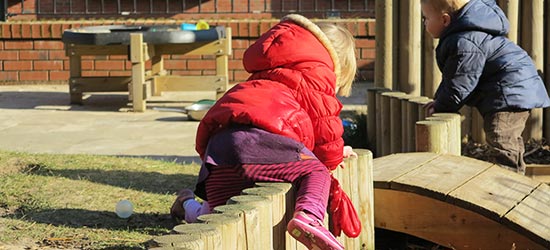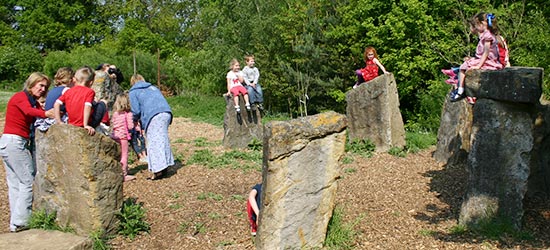Risk-taking and child behaviour: Remove the bubble wrap
Why over-protection hinders healthy child development
| April 2017I’ve got only a few minutes left to spare before I have to leave the house for an appointment and the phone rings. I hesitate before picking it up. There is a lady on the line. “Maybe you can help me,” she says in a sweet voice. “You see, I have this three-year-old little boy that is attending preschool for the first time. The teacher just informed me that he isn’t the ‘perfect fit.’ They say he is too active and that’s a problem. Is there something wrong with him?”
I am in shock. I’ve heard about this time and time again when young children reach elementary school. Many teachers want children sitting in seats in order to work on curriculum. However, the majority of children in the early grades haven’t mastered the art of sitting still yet. But … Preschool? Really? We are expecting children to sit still when they are just barely out of diapers? My blood boils at the notion that something is wrong with an active three-year-old boy.
Sometimes I wish we could go back in time to simpler days. Days when children didn’t start school until age five and then only in the mornings. Their “school” was filled with songs, play, and simple lessons. Afternoons held the promise of naptime and hours of outdoor play with kids in the neighbourhood. Now we are expecting three-year-olds to sit and behave like older elementary-aged children. When they do have time to play outdoors, it is overly restricted and limited to short periods of time. And we wonder why we are seeing “behaviours” in children at an earlier age.
A society afraid of risk-taking
One of the biggest barriers to outdoor play is that our American society has become litigious over the years, and it is starting to take a toll on child development. Schools and even towns are implementing more rules and banning classic childhood pastimes like playing tag, sledding, playing on monkey bars, and jumping off swings. The reason? Some child somewhere got hurt, and now the school or town is fearful of being sued. The easy solution is to get rid of the equipment and forbid the activity. This may be a good short-term solution; however, we have forgotten the importance of allowing children to participate in these activities.
A friend of mine, who is an elementary school teacher, tells me that she had to give up being a recess monitor. “I just couldn’t take it anymore,” she says. “I had to tell the kids not to do things that I knew were good for their development.” For example, the kids were highly restricted in how they could use the swings. “I remember jumping off swings when I was a kid to see how far I could get. Now they are not only forbidden from jumping, but they aren’t allowed to do anything but sit in the swing. I even had to tell them they couldn’t swing on their bellies,” she states. “I’ve had children tell me they are not allowed to spin in circles on the swings and other teachers tell me that kids are not allowed to go on top of the monkey bars.”
Spinning in circles and even going upside down are important for establishing a strong sense of balance. Climbing on top of monkey bars is a great physical challenge, and activities such as sledding strengthen the muscular core and give necessary vestibular input for good body awareness. If we don’t allow our children the freedom to move their bodies in different ways with these simple challenges, how do we expect them to become capable of navigating their environment without getting hurt? Risks and challenges are important for healthy sensory and motor development.
When I was helping to start a TimberNook in New Zealand, I took time to meet Bruce McLachlan, the principal of Swanson Elementary School in Auckland. Bruce did the unthinkable. As part of a local university study, he got rid of rules during recess time. Kids were allowed to scale fences, climb trees, build with construction materials, and ride scooters. A funny thing happened. There was a decrease in the amount of bullying, a drop in the number of serious injuries, and an improvement in concentration in the classroom.
Bruce told me that part of the reason why getting rid of the rules worked in New Zealand is that he doesn’t have to worry about litigation. New Zealanders benefit from a state-run universal insurance scheme administered by the Accident Compensation Commission, which covers medical costs if people injure themselves. Because of this, it is rare for parents in New Zealand to sue a school. In fact, one little boy broke his arm during recess on a scooter. Bruce recalled this experience to me. “The father called me asking if he could come and talk with me. I was thinking the worst. But you know what he said? The father came and stated, “Thank you. Please don’t change the rules for recess because my son got hurt. It is an important life lesson.” I was truly shocked. “The story about Bruce eliminating the rules during recess has gone viral. Adults everywhere are now thinking back to their childhood, when they were allowed more freedom. To them, this story represents a fight against the era of bubble-wrapping our children and instead focusing on the value of free play.
What child-driven play looks like
Children are naturally curious and seek out opportunities to make sense of the world. When children are left to their own devices, they experiment with their surroundings, take risks, make mistakes, and then learn from the mistakes. They problem solve, negotiate, imagine, and investigate. Children learn an immense amount of information through active free play outdoors.
Children know what they need
As adults, we may always feel that we know what is best for our children. A child’s neurological system begs to differ. Children with healthy neurological systems naturally seek out the sensory input they need on their own. They determine how much, how fast, and how high works for them at any given time. They do this without even thinking about it. If they are spinning in circles, it is because they need to. If they are jumping off a rock over and over, it is because they are craving that sensory input. They are trying to organize their senses through practice and repetition.
You may find yourself having a natural tendency to say, “No spinning, you may get dizzy,” or “Get down from that tree, you might get hurt.” However, when we restrict children from experiencing new sensations of their own free will, they may not develop the senses and motor skills necessary to take risks without getting hurt. Then we, the adults, become the barrier to healthy child development.
Children were born to take risks
Children are natural risk takers. During free play, children learn to manage, control, and even overcome their fears by taking risks. Ellen Sandseter, a professor of early-childhood education at Queen Maud University College in Trondheim refers to risky play as a form of exposure therapy, in which children force themselves to do things they’re afraid of in order to overcome their fears. For instance, a child may launch her bike off a jump built of wooden planks or perform new tricks on his skateboard. According to Sandseter, this type of risky play provides a desensitising effect. Through research, she has found that children who injured themselves by falling from heights between ages five and nine are less likely to be afraid of heights when they are eighteen years old (Sandseter and Kennair 2011).
On the other hand, if children never go through the process of exposing themselves to new risks, their fear can turn into a phobia (Rosin 2014). Sandseter states, “Our fear of children being harmed by mostly harmless injuries may result in more fearful children and increased levels of psychopathology” (Tierney 2011). In other words, our parental anxiety can become a barrier to children’s emotional development as well. JoAnn Deak (PhD), author of Girls Will Be Girls, states, “Girls who avoid risks have poorer self-esteem than girls who can and do face challenges” (PBS Parents). Therefore, in order to help deter the rise in social-emotional issues we are witnessing in children today, we would be wise to provide thrilling play experiences for children.
Children take pride in independent play experiences
Letting children take risks boosts their confidence. Using a knife to whittle a stick, exploring without an adult, tending a fire, and creating a fort all have one thing in common: there is the risk of injury. Even though letting kids take risks can be scary for parents, these experiences offer considerable reward and value to growing children.
When a child takes a risk, such as riding a bike for the first time, it can be frightening. At the same time, the child is learning to overcome that fear to reach a goal. In the process of learning to ride a bike successfully, the child learns patience, perseverance, and resilience. She learns to keep trying, even when she continues to fall. In the end, she will be riding her bike well. She overcomes obstacles on her own, which contributes to her confidence. She may think, I did this all on my own. What a great life lesson, because life is a continuous series of trials. Having the confidence to persevere and have patience helps children to be successful with relationships, school, and work experiences later in life.
Taking physical risks improves safety awareness
Not only does taking risks help children overcome their fears and build confidence, but doing so also helps children develop strong physical skills that support good body awareness. Having adequate body awareness is essential for the safe navigation of and interaction with the world around us. There are many simple activities that are excellent for promoting balance and good body awareness:
- Spinning in circles
- Rolling down the hill and back up again
- Dancing
- Gymnastics
- Skating (especially when going backwards, spinning, and turning)
- Playing on the merry-go-round
- Going upside down
- Swinging (on the bottom or belly and while standing or spinning)
- Swimming
- Diving
- Climbing
- Crawling
Although letting kids take risks may be scary for parents and even children at first, it is an essential part of growing up. Taking risks allows children to overcome physical challenges and strengthens their senses at the same time. These benefits ultimately make them safer and more resilient in the long run. Risky play also allows children to overcome fears and anxiety and builds strong character. Children need opportunities to fail and make mistakes in order to become more confident and capable when facing future life challenges.
References
PBS Parents. No date. Raising a Powerful Girl. https://www.pbs.org/parents/parenting/raising-girls/body-image-identity/raising-a-powerful-girl.
Rosin, H. 2014. The Overprotected Kid. Atlantic, April. https://www.theatlantic.com/magazine/archive/2014/04/hey-parents-leave-those-kids-alone/358631.
Sandseter, E., L. E. O. Kennair. 2011. Children’s Risky Play from an Evolutionary Perspective: The Anti-Phobic Effects of Thrilling Experiences. Evolutionary Psychology 9 (2): 257–284. Retrieved from https://www.epjournal.net/articles/children’s-risky-play-from-an-evolutionary-perspective-the-anti-phobic-effects-of-thrilling-experiences/getpdf.php?file=EP092572842.pdf.
Tierney, J. 2011. Can a Playground Be Too Safe? New York Times, July 18. https://www.nytimes.com/2011/07/19/science/19tierney.html?_r=0.









